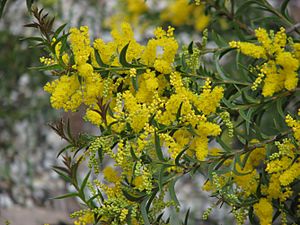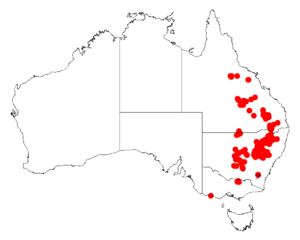Spurwing wattle facts for kids
Quick facts for kids Spurwing wattle |
|
|---|---|
 |
|
| Scientific classification | |
| Genus: |
Acacia
|
| Species: |
triptera
|
 |
|
| Occurrence data from AVH | |
| Synonyms | |
|
Racosperma tripterum (Benth.) Pedley |
|
The Acacia triptera, also known as the spurwing wattle, is a special type of shrub. It grows either straight up or spreads out. This plant is found only in Australia, meaning it is endemic to that country.
Contents
What the Spurwing Wattle Looks Like
This wattle can grow up to 2 m (6 ft 7 in) (about 6.5 feet) tall. Its branches are round and smooth, meaning they are glabrous. Like most Acacia plants, it doesn't have true leaves. Instead, it has what are called phyllodes.
Its Unique Leaves
The phyllodes are like flattened leaf stems that do the job of leaves. They are shaped like a sickle or an "S" curve. These phyllodes are 1.5 to 5.5 cm (0.59 to 2.17 in) long and 2 to 10 mm (0.079 to 0.394 in) wide. They stay green all year round. You can see many tiny lines running along them.
Flowers and Seed Pods
Bright yellow flowers appear from August to November. The flowers grow in groups, usually two at a time, where the leaf meets the stem. These flower-heads are shaped like cylinders. They are 1.5 to 3 cm (0.59 to 1.18 in) long and packed with golden flowers. After the flowers, the plant grows brown seed pods. These pods are often curled or twisted. They are 3 to 8 cm (1.2 to 3.1 in) long and 2 to 4 mm (0.079 to 0.157 in) wide.
Where the Spurwing Wattle Grows
The spurwing wattle likes to grow in certain places. You can find it on sandhills or rocky areas. It lives in different types of plant communities. These include mallee (a type of eucalyptus woodland), open woodlands, or heath (areas with low-growing shrubs). This plant is found in three Australian states: Victoria, New South Wales, and Queensland.
How It Got Its Name
The spurwing wattle was first officially described in 1842. An English botanist named George Bentham gave it its scientific name. He wrote about it in a science paper called the London Journal of Botany. His description was based on plants found north of the Warrumbungles mountain range.
Growing Spurwing Wattle
If you want to grow this plant, it's pretty tough. Once it's established, it can handle dry periods well. It can also survive moderate frost. This makes it a good choice for gardens in certain climates.

